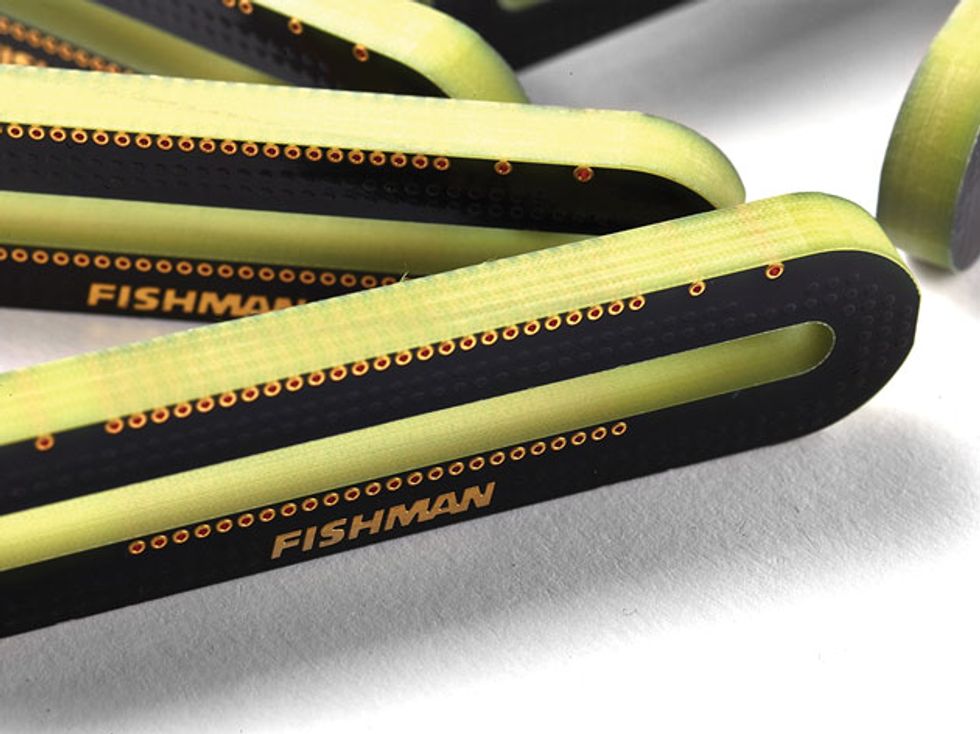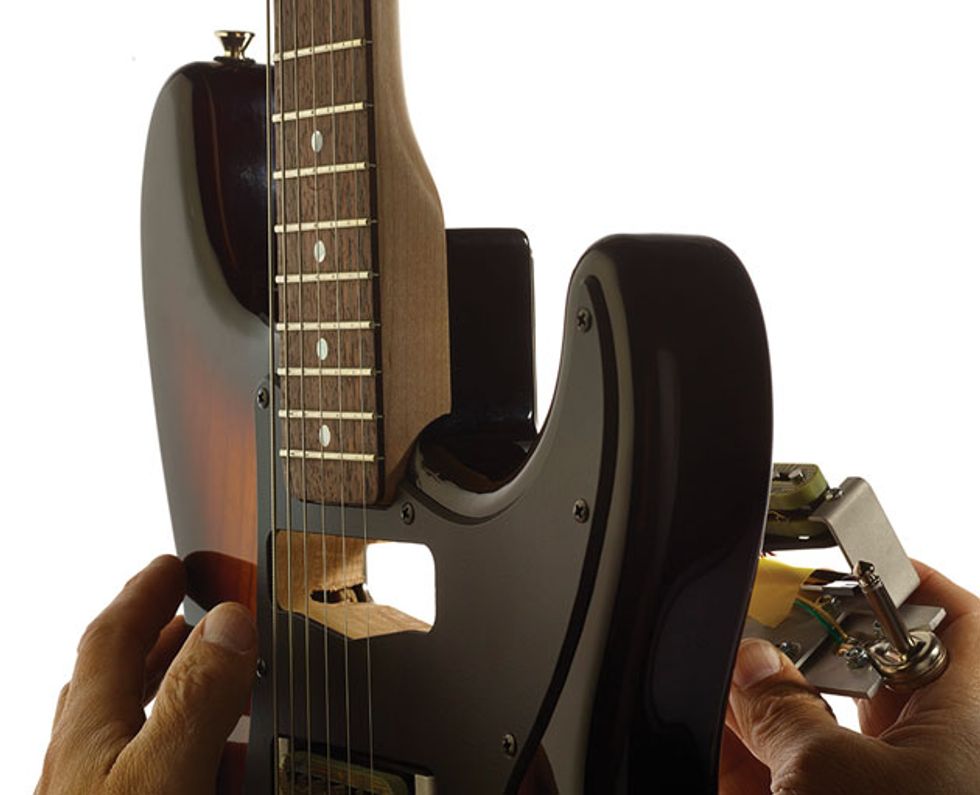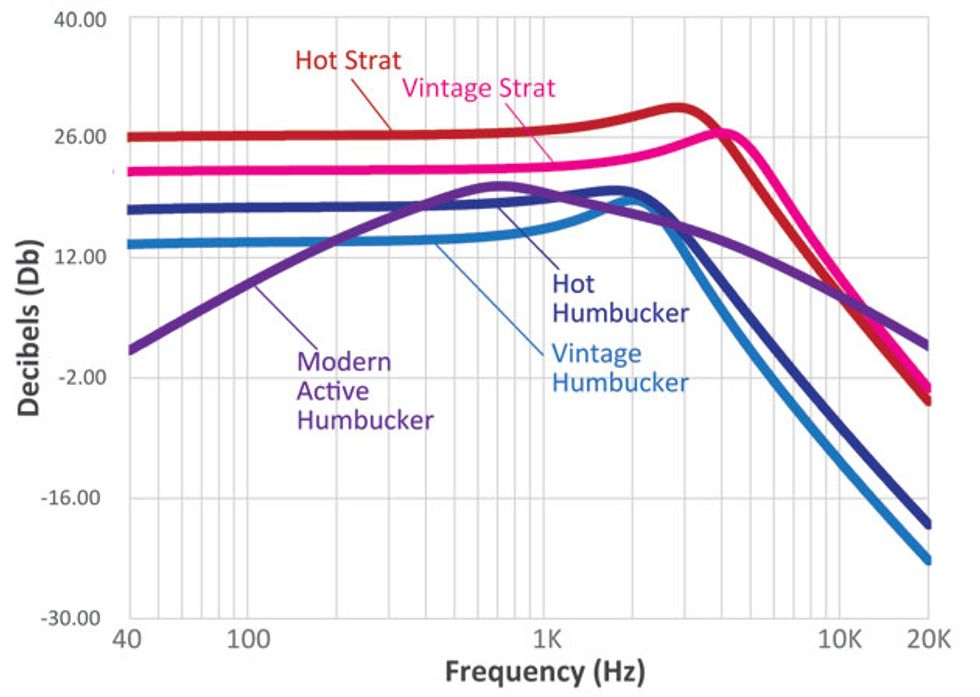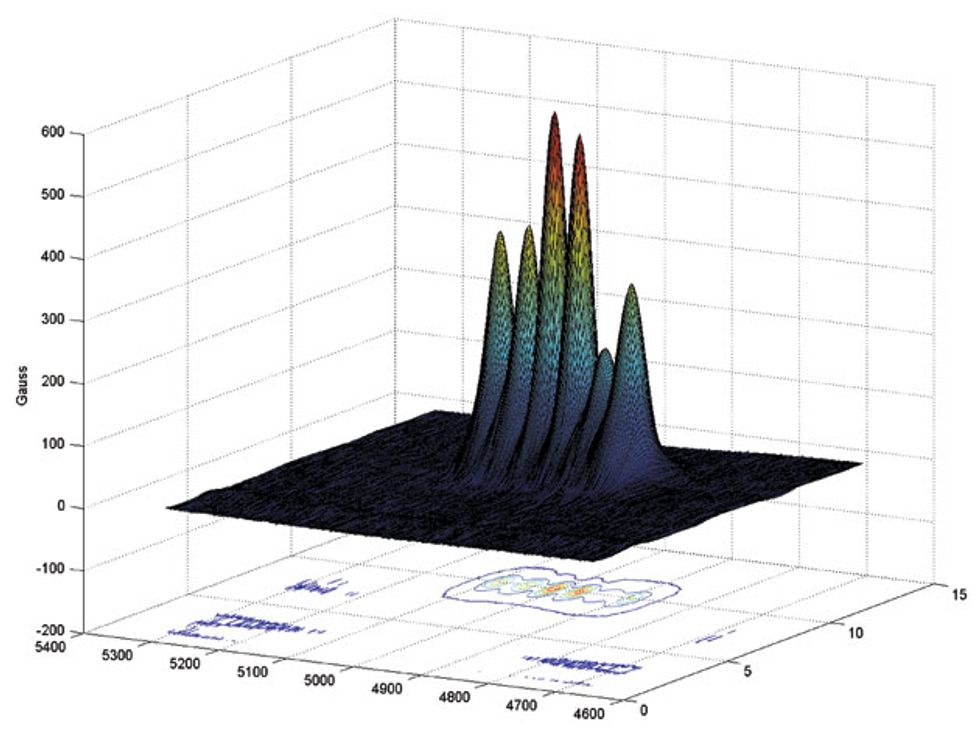
Fluence, Fishman’s first line of electric guitar pickups, marks a radical departure from the traditional technology.
I highly recommend having a conversation with Ritchie Fliegler. Fliegler, a guitar industry vet boasting lengthy tenures at both Fender and Marshall, is psyched about his new collaboration with Larry Fishman. That project can—correction, will—change the way you think about electric guitar pickups.
My initial “pre-interview” with Fliegler lasted almost two hours. We discussed everything from aerospace technology to Lionel trains, from Hendrix’s association with Marshall to why no one considers the New York Philharmonic to be a cover band. And somehow it all seemed relevant. Within days I was on my way to Massachusetts to meet with the team at Fishman.
We’re accustomed to hearing about “the next new thing” in pickups every time NAMM season comes around. What the Fishman team has concocted is not a new sound. Quite the opposite: It’s a way to consistently and accurately recreate the sounds of the world’s best pickups.
Pickups: A Black Art?
Pickup winding can be something of a black art. No matter the manufacturer or the person doing the winding, one pickup can sound different from the next. Even with consistent production methods, there are such wild card factors as inconsistency in the raw materials used by the manufacturer.
Guitars, too, are also full of uncontrollable variables. For one thing, they’re made from trees, and trees vary. So do wood-drying conditions, shaping techniques, manufacturing and assembly methods, and the design of the metal and plastic parts we attach to that wood.
But for all of us electric guitar huggers, sound eventually comes down to that critical point where a vibrating string excites a pickup magnet. The invisible events that occur in that instant are responsible for all the things we love about pickups—and many of the things that frustrate us.
The sound coming from a vintage ’54 Stratocaster pickup or a ’57 PAF humbucker can be magical. But according to Larry Fishman, that “magic” is precisely why his company sidestepped electric guitar pickups for its first 34 years: “Too much voodoo,” he says. Fishman felt he could match the performance of existing electric guitar pickups, but not bring anything new to the party—until now.
About 18 months ago Fishman and his team started thinking about magnetic pickups in a bold unique new way. The result is a new pickup line: Fluence.
A New Path to Old Sounds
Understanding what’s unique about Fluence requires an understanding of how traditional pickups work—and don’t work. Like beloved family members, pickups have their faults. But as anyone associated with Fluence will tell you, this is not a story focused on bashing traditional pickups. Rather, it’s a love story about preserving the best qualities of great pickups without their associated problems, and at a reasonable cost.
Layers of printed coils awaiting magnets. The small rings are “vias” that electrically connect the layers.
A bit of pickup history: In the early 1930s, George Beauchamp applied for a patent on an odd looking guitar-like instrument that included a “pickup.” (The patent uses the variations “pickup,” “pick–up” and “pick up” interchangeably.) His invention was the now-famous Rickenbacker “Frying Pan,” which hosted the first guitar pickup. (To acquire the patent, Adolph Rickenbacker had to send Hawaiian guitarist Sol Hoopii to Washington to demonstrate Beauchamp’s invention, proving to U.S. Patent Office examiners that it worked.)
While there have been thousands of pickup variations and refinements over the last 80 years, most of today’s magnetic guitar pickups aren’t all that different from Beauchamp’s invention. In a conventional pickup, a continuous length of copper wire is wound thousands of times around a bobbin or coil former, surrounding the magnet or magnets. (The wire doesn’t short itself out because the copper strand is coated with a thin layer of insulating material.)
Fluence, however, is based on the notion that coils can be applied rather than wound. Like traces on a circuit board, concentric spirals of “coil” can be printed. Picture, for example, a racetrack- shaped printed circuit board the size of a Stratocaster pickup, with an opening in its center reserved for magnets. One board can hold one spiral, and because it’s printed, each copy is perfectly consistent. The next step involves stacking multiple layers of printed coils and interconnecting them until “pickup” ability is reached. It’s a technique used in the aerospace and telecommunications industries, though it’s never been applied to guitars.
Fishman uses a “shuttle” system to swap pickups instantly.
Perfect Copies
The team had many variables to experiment with: the thickness of each trace, the number of windings, the number and thickness of the layers. But the variables were all controllable—and perfectly reproducible.
Here’s what they came up with after untold iterations: Stack 48 layers on top of each other, add a spacer to provide a gap, and stack another 48 layers below, but with reversed coil direction to cancel hum. Perfectly matched halves perfectly cancel hum. The gap prevents unwanted communication between the upper and lower stacks.
A critical but elusive consideration was the flux properties of the magnets. That’s where Fishman’s Ching-Yu Lin, Ph.D., came in. Lin knew little about guitars before joining Fishman several years ago, but much about acoustic engineering. He set about measuring and visually mapping the magnetic properties of the best-sounding pickups.
Pickups, as you probably know, employ magnets of different materials (alnico 2, alnico 5, ceramic, etc.) and different shapes (bar magnets in humbuckers, magnetic pole pieces in most Fender pickups, and so forth). But the magnets themselves can vary from batch to batch, and sometimes the attractive qualities of a particular pickups result from environmental changes to the magnets after the pickups were manufactured.
Lin set about measuring and visually mapping the magnetic properties of the best-sounding pickups the team could find. The magnetic fields of different pickups produce distinct magnetic maps, so Lin created 3-D visualizations of the fields in order to study each pickup’s unique magnetic fingerprint and create a tangible “magnet goal.”
How to control the variations in the magnets’ properties? Supercharge the magnets, and then de-magnetize them in a controlled way.
From Notes to Voltage
A science class refresher on how a pickup turns guitar playing into voltage: The vibrating metal string excites the pickup’s magnetic field, which causes a matching vibrating current in the copper coil. To make this happen, of course, the string must be within the area of magnetic pull. But the fact that the string is within the magnetic field also affects the eddy currents causing the pull, as well as the vibration of the string itself. The interactions can become far more complex than you might suppose.From Flat to Flavorful
The magnetic properties of a pickup aren’t simply matters of tone and frequency. The interaction between the vibrating string and the magnetic field greatly affects the physical dynamics. The Fluence team’s goal was to also replicate the physical string-and-magnet interaction, informed by Lin’s magnet maps.
Simply positioning magnets in the center of those printed circuit racetracks yields a perfectly flat-sounding pickup. That’s not a tone most players seek, but it’s a perfect platform for replicating the character of different pickups.
With traditional pickups, changing one parameter alters others. For example, adding additional winds increases output and lows, but sacrifices highs. Take Strat pickups: A vintage ’54 pickup has more sparkle than a modern, overwound “Texas”-style pickup with its fatter, more bottom-heavy sound. The new technology permits designers to address those variables with less hard-to-control interactivity.
By starting with a perfectly flat pickup, and then filtering some frequencies while boosting others, the team can “image” the sound of various pickups, tweaking as they see fit. For instance, they can match a hot output of the overwound Strat pickup without sacrificing the high end of the vintage model.
Selectively altering a pickup’s frequency response is old news at Fishman—they’ve done it countless times with their under-saddle piezo pickups. But an exciting new wrinkle of Fluence technology is the possibility of combining multiple profiles in a single pickup. Instead of having to choose between vintage and modern Strat pickups, for example, players could access a switch allowing them to change profiles on the fly. The switch can reside on a standard push/pull pot, so both pickup and pot can be added as a completely reversible modification to most guitars.
Once the printed coils are assembled and the magnets matched, the preamp filters and boosts the signal
to match the curves shown here.
Fluence Benefits
Perfectly consistent and reproducible “printed” coils. A way to replicate the pull of the magnets based on ideal pickups. Accurate and consistent ways to control frequency response. The ability to choose between multiple pickup profiles. It’s impressive—but there’s more.
As mentioned, hum has been eliminated, even from single-coil pickups. The usual method of creating hum-free single-coil pickups—“stacking” two coils—inevitably causes high-end loss. But Fluence can eliminate hum while retaining the original single-coil sound, thanks to filtering and boosting within the preamp.
There are other advantages: A guitar’s volume control and the instrument cable can attenuate high-end frequencies. (In fact, draw a schematic showing a pickup, a volume control, and an instrument cable, and you have a perfect diagram of a tone control.) The instrument cable carries a capacitance—the longer the cable, the higher the capacitance and the greater the high-end loss. That’s not a problem with Fluence, because the pickup connects to a preamp, which acts as a buffer. Tone-wise, what you hear with the volume set to 10 is the same as what you hear when it’s dialed down to 2, only louder. A 10-foot cable sounds identical to a 100-foot cable. Want to use a 100-foot cable with your guitar volume set at 2? No problem.
Ching-Yu’s magnetic “fingerprint” of a particularly great-sounding hot Texas-style Strat pickup. The magnetic pull affects not the just the tone, but the physical dynamics of the string/magnet interaction.
Better Batteries
So it all sounds promising, right? Well, there’s one potential issue: To replicate the sounds of various pickups, Fluence requires a preamp for filtering and gain. And preamps require batteries.
The Fluence team was well aware that most guitarists prefer passive pickups (including all the team members). A battery can be a deal breaker for many players.
The team concluded that the things guitarists dislike most about batteries are their brief lifespans, the hassle and cost of changing them, and the need to carry spares. Their solution was to make the Fluence battery rechargeable via a standard mini-USB plug. The battery runs for 250 hours on a single two-and-a-half hour charge. Unplugging the instrument cable turns Fluence off, conserving juice. (The “off” feature means you may have to replace your existing output jack with a stereo jack.) With a 250-hour charge, you could forget to unplug your guitar, go away for a week, and still have three continuous days of non-stop playing before recharging.
This is what Ritchie Fliegler, Larry Fishman, and the rest of the team are especially excited about.
Fluence: The First Generation
Fluence pickups, single-coil and humbucker versions.
Fishman will unveil its Fluence pickup line at the 2014 Winter NAMM show. There are five initial models, each capable of two contrasting sound images:
· Strat-sized (single width): Voice 1 = vintage single-coil. Voice 2 = hot “Texas” single-coil.· Classic Humbucker (neck position): Voice 1 = vintage PAF. Voice 2 = clean, airy chime.
· Classic Humbucker (bridge position): Voice 1 = vintage PAF. Voice 2 = classic hot rod.
· Modern Humbucker Alnico (neck position): Voice 1 = modern active metal. Voice 2 = crisp, clean, and fluid.
· Modern Humbucker Ceramic (bridge position): Voice 1 = modern active metal. Voice 2 = classic hot rod.
A Fluence Test-Drive
I spent an afternoon auditioning the Fluence system. The Fishman team created modified guitars that allowed us to plug in different pickups from the back. (Using the same guitar means that tonal differences are strictly attributable to the pickups—a super-fun experiment in itself.)
We played single-coil and humbucker versions of the Fluence pickups using a Stratocaster and Les Paul, respectively, switching between classic Marshall and Fender amps. Rob Ketch at Fishman took charge first, putting the pickups through their paces. The guitars sounded absolutely great, and consistent at every volume setting.
 Rob Ketch, Fishman’s VP of OEM Sales, demonstrating a Fluence pickup popped into the bridge position on a guitar modified for quick pickup changes. Turning down the guitar’s volume has no effect on the tone.
Rob Ketch, Fishman’s VP of OEM Sales, demonstrating a Fluence pickup popped into the bridge position on a guitar modified for quick pickup changes. Turning down the guitar’s volume has no effect on the tone.My turn came next. I had a difficult time putting the guitars down, gushing over every note. Within minutes I was completely caught up in the enthusiasm. It was a tonal love-fest.
However, as Martin Mull once said, “Writing about music is like dancing about architecture.” The next step will be for guitarists to audition Fluence pickups themselves. I’m looking forward to hearing their reactions, as is, of course, everyone on the Fishman team.
All members of the Fishman team emphasize that they are not rethinking the way pickups should sound, though they are reimagining the way pickups are manufactured in pursuit of that sound. “Our goal,” says Larry Fishman, “is to drive all amplifiers to happiness.”
Ritchie Fliegler admitted in our first conversation that he wouldn’t remove the original pickups from his ’54 Stratocaster anytime soon—that would be blasphemy! But he says he’s excited that many of us can get that sound in our guitars and reap additional sonic benefits—and then get back to making music.
- Cult Coils: Lesser-Known Vintage Pickups - Premier Guitar ›
- Fishman Releases the Fluence Greg Koch Gristle-Tone Signature Series P-90 - Premier Guitar ›
- Ruf Guitars Unveils the Schrödinger - Premier Guitar ›
- Riversong Glennwood TS6 Acoustic Guitar Review - Premier Guitar ›
- Fishman Fluence Greg Koch Gristle-Tone P-90 Review - Premier Guitar ›





